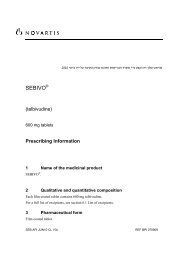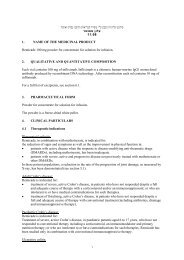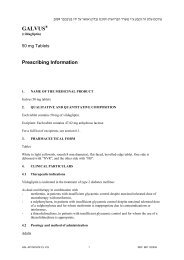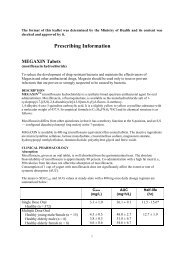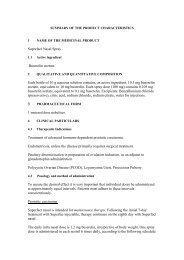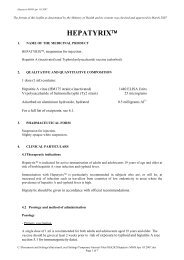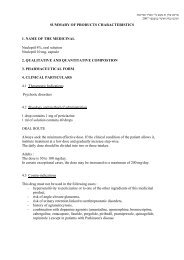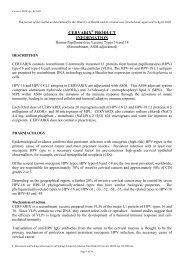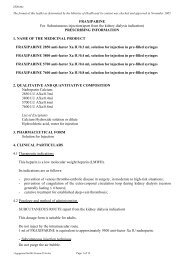KIDROLASE 10,000 I.U.
KIDROLASE 10,000 I.U.
KIDROLASE 10,000 I.U.
Create successful ePaper yourself
Turn your PDF publications into a flip-book with our unique Google optimized e-Paper software.
one marrow tests should be monitored<br />
regularly during therapy.<br />
• Glycemia and amylasemia should be<br />
monitored all along therapy. The treatment<br />
should be withdrawn in case amylasemia<br />
level increases.<br />
• Patients should be monitored to detect and<br />
prevent cytolysis which can lead to<br />
hyperuricemia.<br />
Interactions with other drugs and<br />
other forms of interaction<br />
Associations to be taken into<br />
consideration<br />
Attenuated live vaccines: risk of possibly fatal<br />
disseminated disease. This is even more likely<br />
to occur in subjects already<br />
immunosuppressed by the underlying disease.<br />
Use an inactivated vaccine when available<br />
(poliomyelitis).<br />
Drug interactions<br />
Tissue culture and animal studies indicate that<br />
asparaginase can diminish or abolish the effect<br />
of methotrexate on malignant cells. This effect<br />
on methotrexate activity persists as long as<br />
plasma asparagine levels are suppressed.<br />
These results would seem to dictate against<br />
the clinical use of methotrexate with<br />
asparaginase, or during the period following<br />
asparaginase therapy when plasma asparagine<br />
levels are below normal.<br />
Drug/laboratory test interactions<br />
L-asparaginase has been reported to interfere<br />
with the interpretation of thyroid function tests<br />
by producing a rapid and marked reduction in<br />
serum concentrations of thyroxine-binding<br />
globulin within two days after the first dose.<br />
Serum concentrations of thyroxine-binding<br />
globulin returned to pretreatment values within<br />
four weeks of the last administration of<br />
L-asparaginase.<br />
Pregnancy and breast-feeding<br />
This drug is contraindicated during pregnancy<br />
and for nursing mothers.<br />
Pediatric use<br />
Asparaginase toxicity is reported to be greater<br />
in adults than in pediatric patients.<br />
Adverse effects<br />
Hypersensitivity is the most frequent adverse<br />
reaction, such as urticaria, edema of the larynx,<br />
bronchospasm, hypotension or even true<br />
anaphylactic shock. If these reactions occur,<br />
the treatment should be discontinued<br />
immediately and withdrawn (see<br />
Contraindications).<br />
• In pediatric patients with advanced<br />
leukemia, a lower incidence of anaphylaxis<br />
has been reported with intramuscular<br />
administration, although there was a higher<br />
incidence of milder hypersensitivity reactions<br />
than with intravenous administration.<br />
• Fatal hyperthermia has been reported.<br />
Inhibition of protein synthesis:<br />
• Clotting disorders including increased PT<br />
and thromboplastin time with<br />
•<br />
hypofibrinogenemia, decrease in antithrombin<br />
III, plasminogen and other factors<br />
(VII, IX, X and VIII), leading to possible<br />
bleeding and thrombotic complications:<br />
Decrease in serum insulin with<br />
hyperglycemia; glucosuria and polyuria.<br />
• Inhibition of lipoprotein lipase activity;<br />
increase in serum triglycerides and<br />
cholesterol.<br />
• Decrease in brain concentrations of<br />
L-asparagine or L-glutamine, resulting in<br />
hyperammonemia with clinical signs of<br />
metabolic encephalopathy such as<br />
consciousness disorders with confusion,<br />
stupor or coma in some patients.<br />
Some patients have shown central nervous<br />
system effects consisting of depression,<br />
somnolence, fatigue, coma, confusion,<br />
agitation and hallucinations varying from mild<br />
to severe. Rarely, a Parkinson-like syndrome<br />
has occurred, with tremor and a progressive<br />
increase in muscular tone. These side effects<br />
usually have reversed spontaneously after<br />
treatment was stopped. Therapy with<br />
asparaginase is associated with an increase<br />
in blood ammonia during the conversion of<br />
asparagine to aspartic acid by the enzyme.<br />
No clear correlation exists between the degree<br />
of elevation of blood ammonia levels and the<br />
appearance of CNS changes.<br />
Other adverse effects:<br />
• Acute pancreatitis, including fatalities.<br />
• Cholestatic or hepatocellular liver injury with<br />
or without steatosis.<br />
• A variety of liver function abnormalities have<br />
been reported, including elevations of<br />
SGOT, SGTP, alkaline phosphatase,<br />
bilirubin (direct and indirect), and depression<br />
of serum albumin, cholesterol (total and<br />
esters), and plasma fibrinogen. Increases<br />
and decreases of total lipids have occurred.<br />
Marked hypoalbuminemia associated with<br />
peripheral edema has been reported.<br />
However, these abnormalities usually are<br />
reversible on discontinuance of therapy and<br />
some reversal may occur during the course<br />
of therapy. Fatty changes in the liver have<br />
been documented by biopsy. Malabsorption<br />
syndrome has been reported.<br />
• Rarely, transient bone marrow depression<br />
has been observed, as evidenced by a<br />
delay in return of hemoglobin or hematocrit<br />
levels to normal in patients undergoing<br />
hematologic remission of leukemia.<br />
• Marked leukopenia has been reported.<br />
• Nausea, vomiting, chills, fever, anorexia,<br />
abdominal cramps, weight loss.<br />
• Amenorrhea, azoospermia.<br />
• Headache and irritability may occur and<br />
usually are mild.<br />
• Azotemia, usually pre-renal, occurs<br />
frequently. Acute renal shut down and fatal<br />
renal insufficiency have been reported<br />
during treatment. Proteinuria has occurred<br />
infrequently.<br />
Overdosage<br />
The acute intravenous LD 50 of asparaginase<br />
for mice was about 500,<strong>000</strong> I.U./kg and for<br />
rabbits about 22,<strong>000</strong> I.U./kg.<br />
PHARMACOLOGICAL PROPERTIES<br />
Pharmacodynamic properties<br />
OTHER ANTINEOPLASTICS<br />
(L: Antineoplastics and immunomodulators)<br />
L-asparaginase is a protein enzyme extracted<br />
from Escherichia coli which degrades<br />
asparagine by hydrolysis.<br />
This amino acid is one of the basic constituents<br />
of cellular protein. As leukemic cells cannot<br />
synthesize asparagine endogenously, they<br />
are dependent on an exogenous source of<br />
asparagine for survival. Depletion of<br />
asparagine by treatment with L-asparaginase<br />
results in the death of cells unable to synthesize<br />
asparagine endogenously. Due to this special<br />
mechanism of action, cross-resistance with<br />
other cytostatic agents is not observed.<br />
Pharmacokinetic properties<br />
Tissue diffusion of L-asparaginase is low. It<br />
has a biphasic half-life ranging from 8 to 30<br />
hours according to subject. 24 hours after an<br />
IV dose of 1,<strong>000</strong> I.U./kg, plasma concentrations<br />
were 8 to 20 I.U./ml, while plasma<br />
concentrations after an IM injection were 50%<br />
lower.<br />
PHARMACEUTICAL DATA<br />
Shelf-life<br />
Before reconstitution: 2 years.<br />
After reconstitution: see Special precautions<br />
for storage.<br />
Special precautions for storage<br />
Before reconstitution: store at a temperature<br />
between 2°C and 8°C.<br />
After reconstitution: the reconstituted solution<br />
may be kept for 24 hours at a temperature<br />
between 2°C and 8°C.<br />
Instructions for use/handling<br />
This drug must be handled and prepared with<br />
caution. The use of gloves, safety glasses and<br />
a mask is recommended.<br />
In case of contact of the solution for dilution<br />
or the infusion solution with the skin, wash<br />
immediately and thoroughly with soap and<br />
water.<br />
In case of contact of the solution for dilution<br />
or the infusion solution with mucous<br />
membranes, wash immediately with copious<br />
amounts of water.<br />
Do not mix with other drugs.<br />
Manufacturer<br />
OPi S.A., France.<br />
Importer<br />
CTS Ltd.,<br />
4 Haharash Street, Hod Hasharon.<br />
SH 0905



